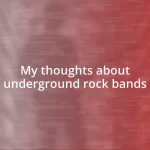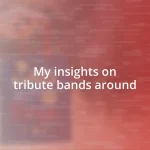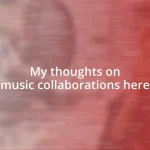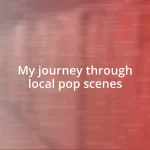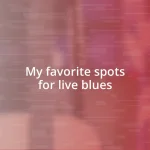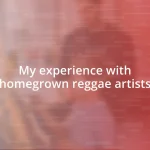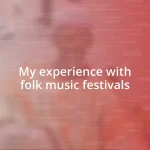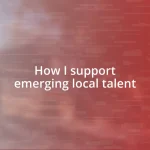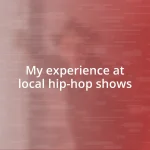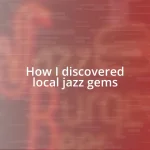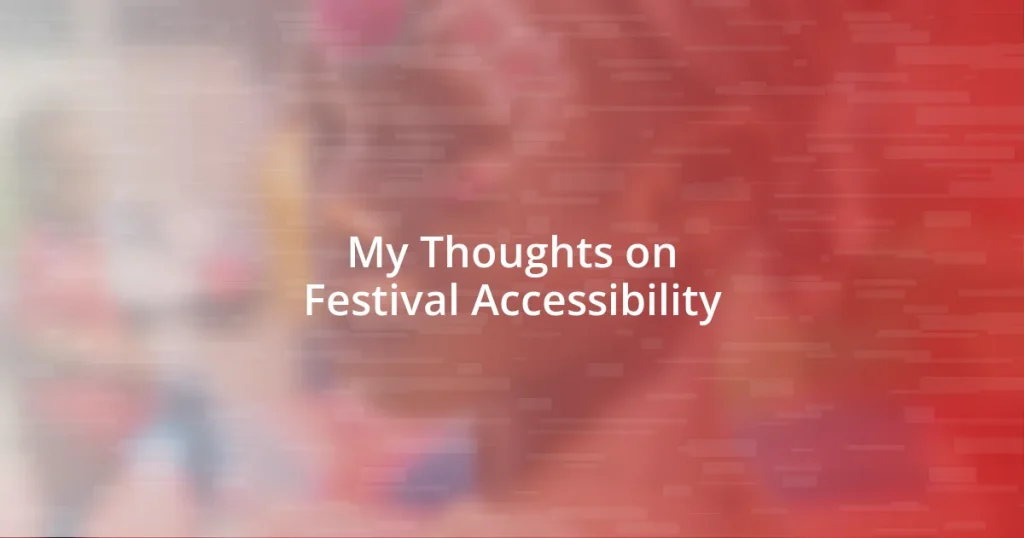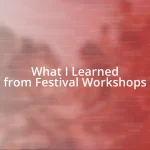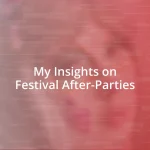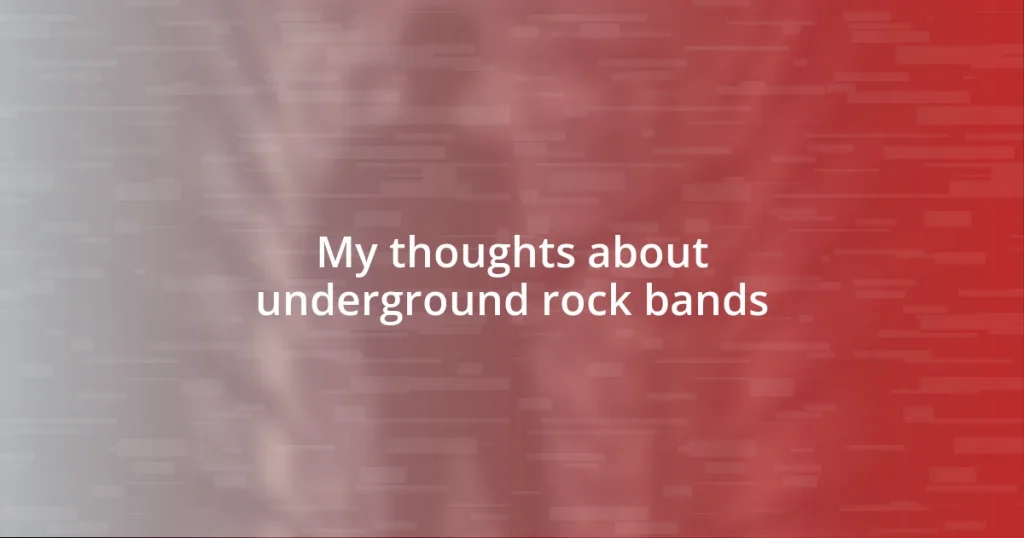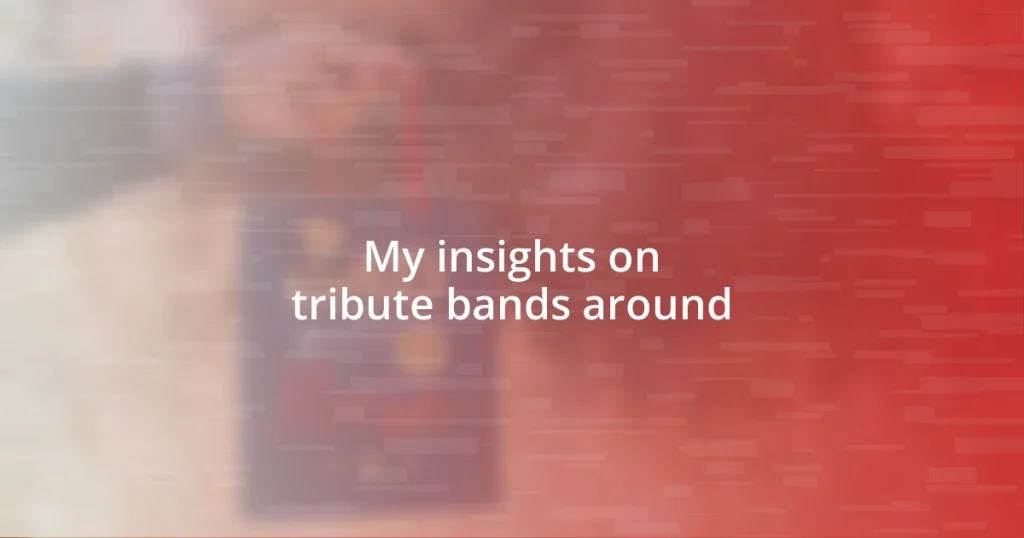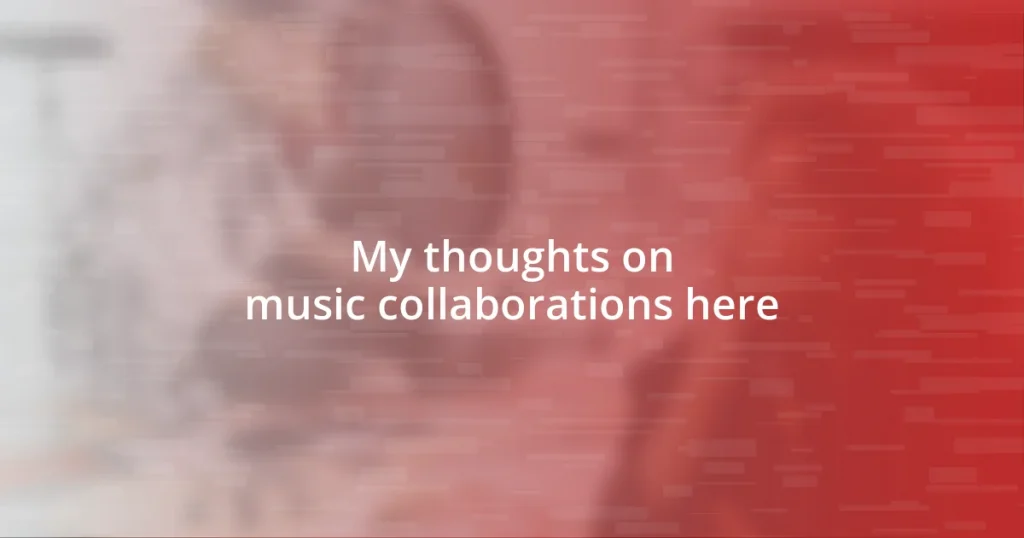Key takeaways:
- True festival accessibility goes beyond physical accommodations, focusing on fostering an inclusive environment that addresses social, sensory, and communication needs.
- Community collaboration and staff training in accessibility awareness are essential for creating enjoyable experiences for all attendees.
- Advancements in technology, such as mobile apps and assistive devices, significantly enhance accessibility and participation at festivals.
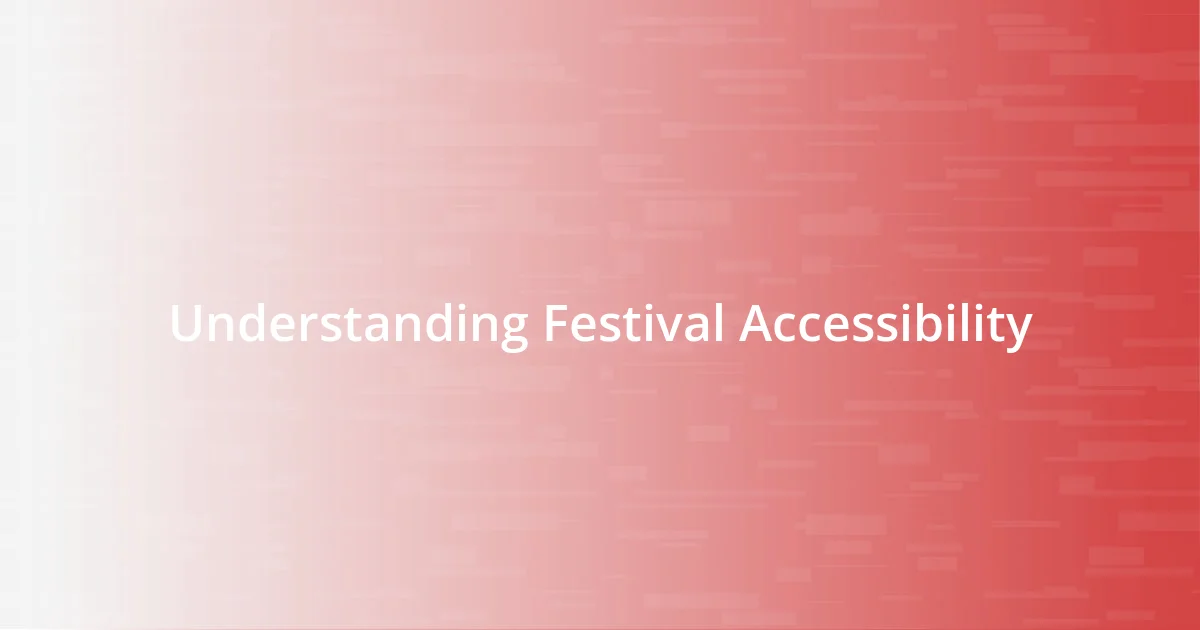
Understanding Festival Accessibility
Understanding festival accessibility means looking beyond just physical accommodations; it’s about creating an inclusive environment where everyone can fully engage in the celebration. I once attended a music festival where accessible seating was available, yet navigating the crowd was a challenge for some. It made me wonder: how often do we think about the barriers that prevent festival-goers from enjoying themselves?
I remember a friend of mine, who uses a wheelchair, shared her experience at a larger festival. She appreciated the ramps and specially designated areas but felt isolated when she couldn’t access close viewing spots for her favorite bands. This made me realize that true accessibility is not just about infrastructure; it’s also about fostering a culture of inclusion where everyone can connect and enjoy the experience without feeling marginalized.
Moreover, it’s essential to consider sensory accessibility at festivals. For instance, my cousin, who has autism, struggles with loud noises and crowded spaces. When she attended a festival that provided quiet zones and sensory-friendly options, it transformed her experience. Have you ever thought about how these small adjustments can make a world of difference? It’s a reminder that accessible design and thoughtful considerations can unlock a truly joyous experience for every festival attendee.
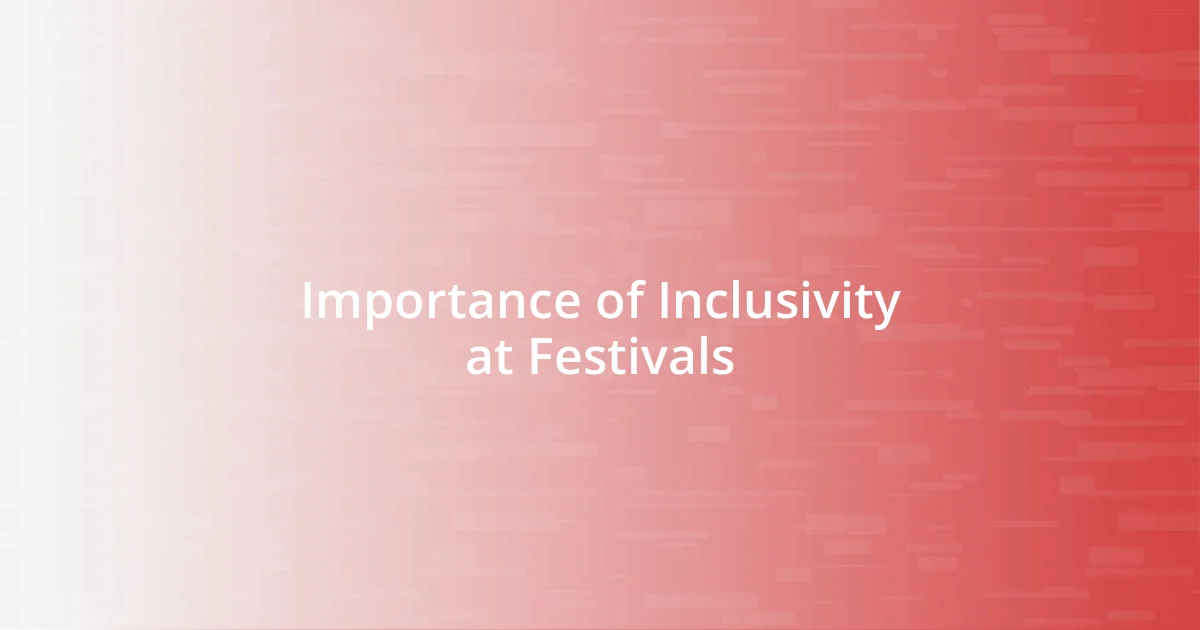
Importance of Inclusivity at Festivals
Inclusivity at festivals is crucial because it creates a sense of community and belonging for everyone involved. I recall attending a local arts festival where volunteer ambassadors were stationed to assist attendees with disabilities. Their kindness and proactive help not only made the event more enjoyable but also fostered a welcoming atmosphere. It struck me how these small touches could turn a lively gathering into a memorable experience for individuals who often feel overlooked.
- Inclusivity allows for diverse perspectives, enriching the festival experience for all attendees.
- An inclusive environment encourages engagement, leading to a broader audience and heightened participation.
- Small actions, like providing clear signage and designated pathways, significantly reduce barriers faced by attendees with disabilities.
When I visited another festival last summer, I was moved by how differently everyone interacted. A family with a visually impaired member shared how accessible maps and audio guides provided by the organizers made their experience easy and enjoyable. Observing their joy reminded me that inclusivity is not just a checklist but a sincere commitment to ensuring everyone can celebrate together.
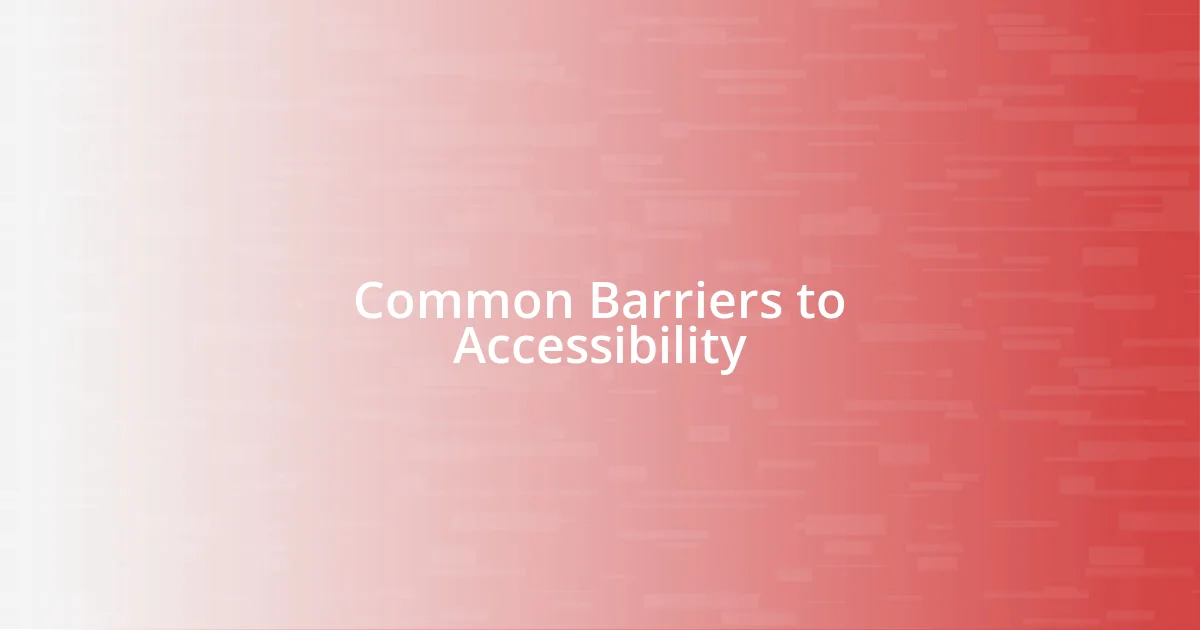
Common Barriers to Accessibility
Navigating through festivals can present a range of barriers that compromise accessibility. One of the most common obstacles is the lack of accessible pathways. I remember getting stuck in a massive crowd at a popular festival; it frustrated me to witness attendees with mobility devices struggling to find their way through. Instead of enjoying the music, they were focused on overcoming hurdles like uneven ground or blocked access. This experience highlighted the importance of not just having ramps but ensuring that the entire event space is designed for smooth navigation.
Moreover, communication barriers often go unnoticed. I encountered a situation at an art festival where the information was primarily posted in fine print or complicated jargon. A couple of friends who are hearing impaired shared how they struggled to find out about scheduled performances due to the absence of visual aids. This made me reflect on how essential it is for festival organizers to provide diverse communication methods, including sign language interpreters and large-print materials, to cater to everyone’s needs.
Lastly, the sensory overload often found at festivals can deter individuals who are neurodivergent or have sensory sensitivities. I once walked through a festival area buzzing with flashing lights and loud music, and I could sense the discomfort on faces around me. A family I spoke with later that day mentioned how overwhelming it was for their child with sensory processing challenges. They felt that although some quiet zones were present, better signage would have made them more accessible. It made me think: how can we enhance these experiences by being proactive rather than reactive?
| Barrier Type | Impact on Attendees |
|---|---|
| Physical Accessibility | Difficulties in navigating and enjoying spaces, often leading to isolation. |
| Communication Barriers | Exclusion from information about events, resulting in a lack of engagement. |
| Sensory Overload | Overwhelming experiences that can deter attendance for those with sensitivities. |
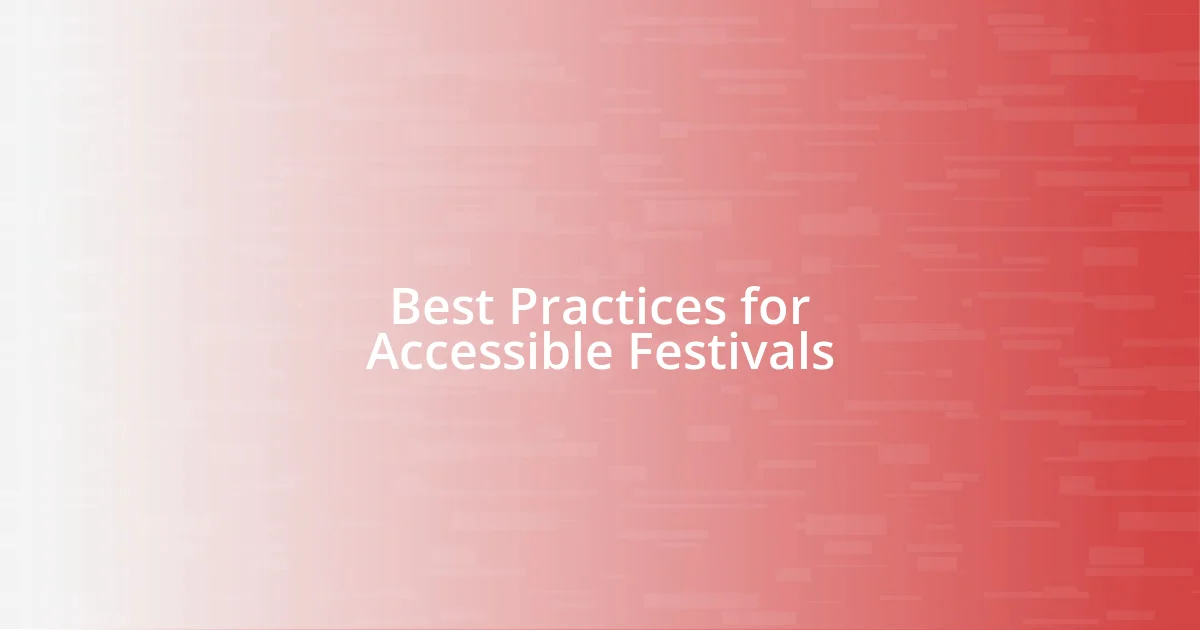
Best Practices for Accessible Festivals
Creating an accessible festival experience requires thoughtful planning and attention to detail. One of the best practices I’ve seen is the incorporation of dedicated accessibility teams throughout the event. Imagine a team of friendly faces who not only assist but actively engage with attendees, making everyone feel seen and heard. During a festival I attended recently, this initiative transformed the atmosphere; it was comforting to know that help was available at any time, whether it was to find a quiet space or to navigate through the crowd.
Accessibility isn’t just about physical provisions; it extends to how information is presented. I once visited a festival where the organizers distributed multi-sensory guides that included tactile maps and audio descriptions. It felt revolutionary! An elderly couple near me shared how they had struggled before with typical printed schedules, but this inclusive approach allowed them to plan their day effortlessly. Such innovations prompt me to ask: what if all festivals adopted similar strategies to ensure everyone can make the most of their experience?
Another practice I’ve found effective is flexible seating arrangements. At one festival, organizers included various seating options—for example, soft lounges alongside traditional chairs. I noticed that families with small children and those with mobility challenges gravitated toward these inviting spaces. It made me wonder, how can we rethink comfort to enhance participation? Ensuring that every attendee not only finds a place to sit but feels welcomed and accommodated can elevate the entire festival experience, reminding us that comfort plays a significant role in inclusivity.
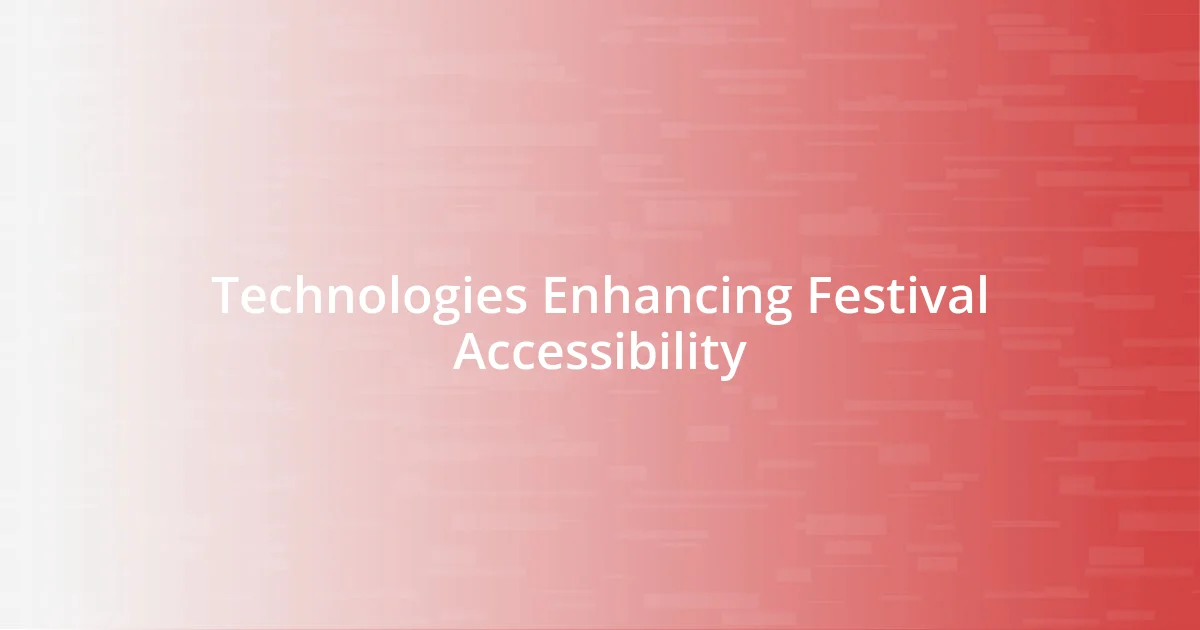
Technologies Enhancing Festival Accessibility
Technology is playing a transformative role in enhancing festival accessibility. For instance, I attended a music festival last summer that featured an app designed specifically for those with accessibility needs. This app showcased real-time updates about accessible routes, available facilities, and even crowd density. It was eye-opening to see so many attendees happily navigating their experiences without the worry of being left behind or missing out.
Assistive technologies, like portable ramps and sensory-friendly earplugs, are also becoming commonplace. I distinctly remember one festival where a vendor provided these tools on loan for free. This thoughtful initiative caught my attention—a young woman in a wheelchair told me how the ramp made her able to attend the performances she loves without anxiety. It made me consider how crucial it is for festivals to not only offer these technologies but to actively promote them to ensure everyone knows they’re available.
Moreover, virtual reality (VR) is emerging as a fascinating option. I once participated in a demo at a festival where VR was used to simulate different festival environments, allowing individuals to prepare themselves for sensory experiences beforehand. I chatted with a gentleman who was excited about this technology; he felt empowered knowing he could decide in advance how to approach the crowd or music levels. Isn’t it incredible that technology can offer such a customizable experience, providing a way for attendees to engage at their comfort level?
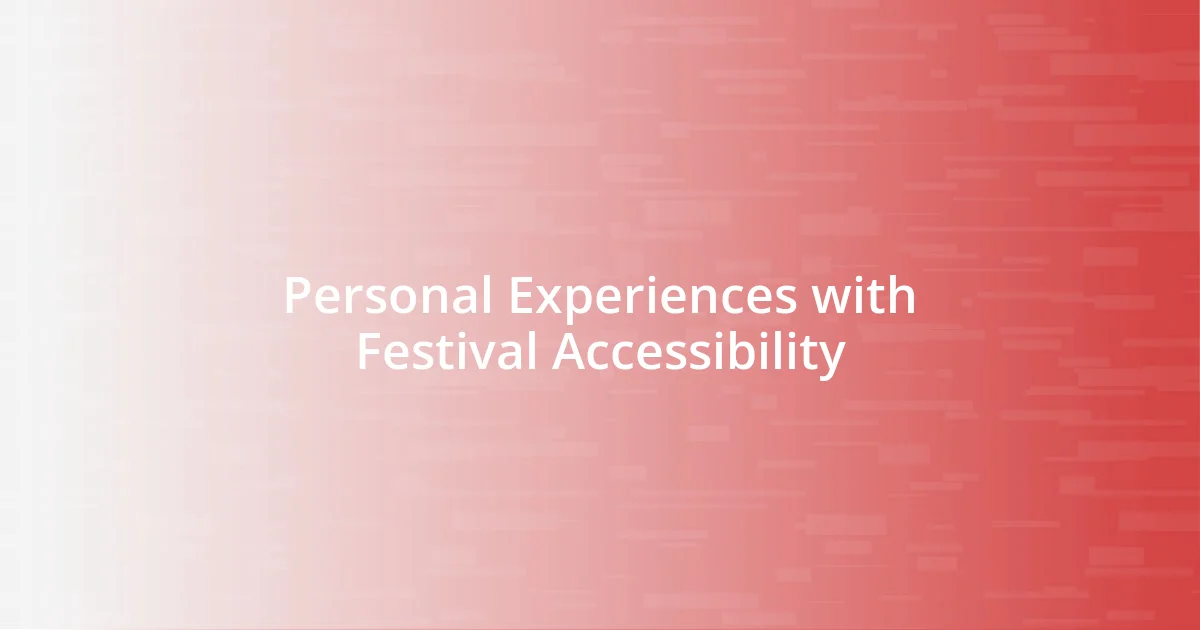
Personal Experiences with Festival Accessibility
I remember attending a smaller, local festival a couple of years ago that really tested my views on accessibility. The organizers didn’t clearly mark accessible entrances, which led to confusion among attendees, including my friend who uses a mobility aid. Watching her struggle through the crowd opened my eyes to how vital clear communication is. It really made me question: how can festivals expect everyone to enjoy the experience when basic navigation isn’t prioritized?
Another experience that sticks with me is a festival where they offered guided tours for those with sensory sensitivities. I accompanied a friend who has autism, and seeing how the staff adjusted the music levels and provided verbal cues was heartwarming. She felt comfortable enough to explore areas that would usually trigger her anxiety. It made me reflect on the little things that can profoundly impact someone’s experience—what if all festivals considered the unique needs of every attendee in such a thoughtful way?
At a different festival, I noticed how the use of friendly volunteers to guide attendees who had questions or needed assistance really created a welcoming environment. One volunteer took the time to sit with me and explain which areas were best for viewing performances with minimal crowd noise. It was a small gesture, but it made a huge difference in my comfort level. It got me thinking: what could that same level of personalized attention achieve in making every festival experience not just accessible, but genuinely enjoyable?
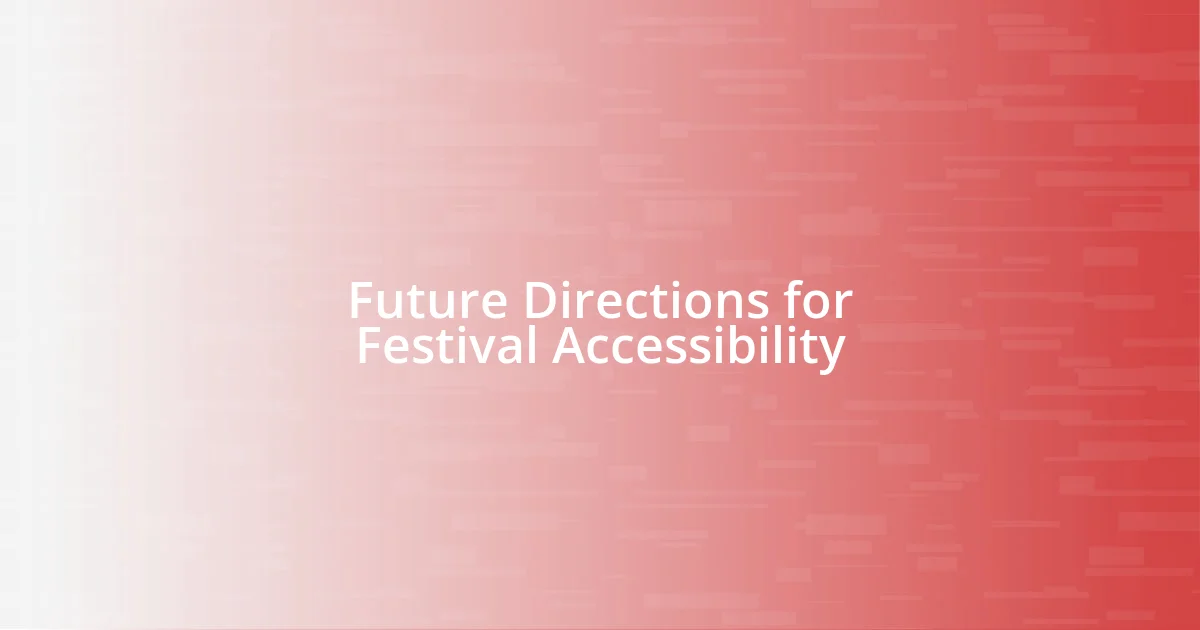
Future Directions for Festival Accessibility
Looking ahead, I see a promising trend in festival accessibility centered on community collaboration. Imagine festivals partnering with disability advocacy groups to co-create experiences tailored for various needs. I once volunteered at an event where input from such groups transformed the layout and amenities, making it more inclusive. This collaboration sparked deep conversations that changed how we approached accessibility—what if every festival took that to heart?
Additionally, I believe we’ll see more emphasis on training staff in accessibility awareness. The difference it makes is staggering. I recall a festival where I watched an attendee needing assistance approach staff who hadn’t been properly trained. The awkwardness was palpable, and it left everyone feeling uncertain about the help available. What if festivals committed to comprehensive training, ensuring that all staff would be ready and eager to assist? This could foster an atmosphere where everyone feels valued and understood.
Finally, advancements in mobile and wearable technology hold incredible potential to enhance the festival experience. I’ve had moments where wearable devices seamlessly tracked my energy levels and sent notifications about quiet areas or accessible facilities nearby. This proactive approach to accessibility not only empowers attendees to manage their experiences but also invites a broader range of people to participate fully. As our technology evolves, why not let it lead the way in creating inclusive spaces that celebrate diversity?
